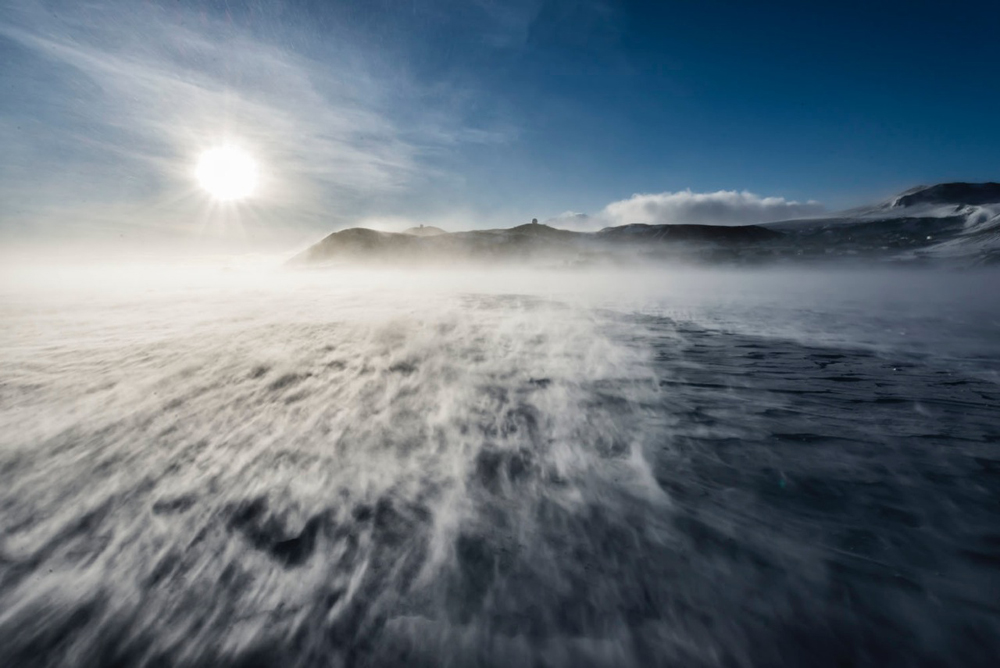Stormy weatherHeavy snowfall, strong winds hit McMurdo in August and SeptemberPosted October 3, 2014
Stormy weather. It’s been a familiar tune the last couple of months at McMurdo Station, where more than 62 inches of snow fell in August. The storms in August produced 22 days when the station was under condition 1 or 2. There are three classes of weather under which McMurdo Station operates. Condition 3 represents mild weather in Antarctic terms. Condition 2 is activated when the weather really starts to deteriorate. In that case, winds speeds are clocked at 48 to 55 knots (55 to 63 miles per hour), wind-chill temperatures have dropped to minus 75 to minus 100 degrees Fahrenheit, and/or visibility is less than one-quarter mile.
Video Information
The clip above shows a Condition 1 storm blowing through McMurdo Station. Video Credit: Alasdair Turner.
Condition 1 represents the worst weather conditions, and can involve wind speeds greater than about 55 knots (63 mph), wind chills colder than minus 100F or visibility of less than 100 feet. During the August storms, condition 1 mainly existed on the nearby ice shelf, where the station has its aircraft operations facilities. In fact, one storm, packing condition 1 winds, slammed into McMurdo around late August, delaying the first flights to the U.S. Antarctic Program’s largest research base by four days. [See previous article — Safe landings: Five flights arrive at McMurdo Station in August to prepare USAP for 2014-15 season.] On Aug. 18, the station broke a daily record for maximum snowfall when eight inches fell on that day. Another record amount may have fallen on Aug. 20. However, sustained winds clocked at 58 knots (67 mph) – with gusts of up to 69 knots (79 mph) – prevented weather observers from accessing a snow catcher on the roof of a building for more than 42 hours. Total snowfall during the 42-hour period was 18.5 inches. No wind records were broken on Aug. 20, but there were plenty of windy days during the month. There were a couple of days when the maximum sustained winds were over 40 knots (46 mph) with max gusts in the 50s for three days. There were eleven days in August when maximum winds hit 30 knots (35 mph) with gusts of 40 knots (46 mph). There was a total of 21 days of blowing snow and 28 days with some form of precipitation, either ice crystals or snow, during the month of August. September has been a little better, with estimated snowfall through Sept. 23 of 6.7 inches, with 18 days of some form of precipitation (either snow or ice crystals) occurring and 14 days of blowing snow. The impacts on the station itself have been relatively minor, according to Jim Scott, infrastructure and operations manager for the Antarctic Support Contract. “The team on the Ice said there weren’t many impacts to town as far as snow buildup,” he said. “Sounds like the winds caused some drifting but nothing out of the ordinary.” Construction of the new ice pier in Winter Quarters Bay was slowed by the stormy weather, which is usually accompanied by warmer temperatures. The pier is about 14 feet thick, approximately a foot short of the planned 15-foot thickness. A storm last summer in McMurdo Sound destroyed the previous pier. [See previous article — Harsh continent: Storms and waves batter McMurdo Station due to absence of sea ice.] July was also a month of weather extremes. A storm in the middle of the month dropped 10 inches of snow over a 30-hour period. While it didn’t break the daily record of 13 inches in a 24-hour period set in 2011, it did cause considerable snowdrifts throughout station. Temperatures during July ranged from bitterly cold to practically balmy. McMurdo Station’s minimum recorded temperature in July was minus 44F. A few days later, it was followed with a maximum temperature reading of positive 14F. On July 16, New Zealand’s Scott Base recorded a record-setting low ambient temperature of minus 67F, confirmed by McMurdo personnel working on the nearby ice shelf, who recorded minus 70F temperatures at the same time. Possibly the most remarkable thing about this weather event was that, only two miles away, McMurdo Station recorded temperatures 30 degrees warmer. (Catherine Salazar contributed to this report.) |



For USAP Participants |
For The Public |
For Researchers and EducatorsContact UsU.S. National Science FoundationOffice of Polar Programs Geosciences Directorate 2415 Eisenhower Avenue, Suite W7100 Alexandria, VA 22314 Sign up for the NSF Office of Polar Programs newsletter and events. Feedback Form |


